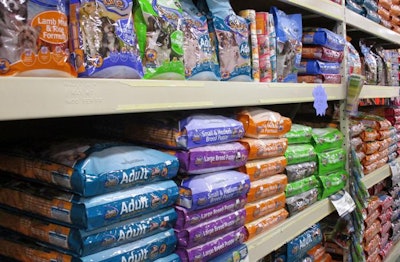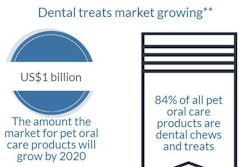
Tis the season for lists and musings on various trends for the coming year, and pet food is not immune. (Guilty as charged.) For a slightly different twist, Mintel recently released a report on global packaging trends for 2017, and the five listed include elements that would seem to naturally attract pet food purchasers, too.
1. (Re)union of package structure and branding. Mintel’s analysts believe that with the focus on clean labels in human food – which we know pet owners are also expecting in pet food – and some consumers equating packaging quality with product quality (one-third of US adults say this), the time is ripe for brands to push innovative packages. Unique packaging can differentiate your product on the shelf while also helping form and support your brand’s identity and giving consumers incentive to spend time with the brand, the Mintel report said. “The bottom line: Good packaging protects your product. Great packaging protects your brand.”
While the examples shown in the report are not directly relatable to pet food (laundry detergent, skin care, beverages, sour cream), the main concepts can still apply. “Purchase drivers are either being directly related to or communicated through packaging,” said Beth Bloom, Mintel senior food and drink analyst.
2. The face and role of packaging online. Though ecommerce accounts for only a small share of sales for most consumer products, including pet food (just 3 to 4 percent in the US), its importance and influence are increasing, the Mintel report rightly stressed. For example, about 75 percent of UK consumers say they expect to do most of their shopping online within 10 years, according to the report. “What this means for packaging is less clear in the short term, but currently, brands are failing to impress with the delivery of their online packaging experience.”
The examples showcased tips and ideas such as personalization; clean, decluttered design and images; a clear color scheme; and a visible, identifiable logo.
3. Packaging gets smart, active and intelligent. A color-changing label that automatically signifies product freshness. A small, flexible label composed of thin, rewritable electronic film. The SmartLabel mobile-enabled technology that allows consumers to scan a label with their phones to obtain detailed information about the product, its ingredients and sourcing, and other elements. (Large food companies that also own pet food divisions, like Nestlé and Tyson Foods, had initially been reported as signing on to the SmartLabel program, but a current list does not include those companies or any other pet food players.)
These examples in the Mintel report highlighted the many opportunities for brands to use packaging to “engage, educate and entertain consumers in real time.” The rapidly developing field of so-called smart or intelligent packaging is being driven by increasing consumer demands for transparency, food safety, waste reduction, patient compliance and the need to avoid exposure to hazardous or fraudulent products. “The smartest, most intelligent packaging is often the most intuitive,” the report said.
4. The experience of packaging. Consumers, especially younger ones, are seeking experiences, even when shopping and interacting with the products they buy and use. This doesn’t mean just eye-catching packaging designs that stand out on the shelf; it also means items like personalized sports drinks, with the packaging including pods containing dry and liquid ingredients that the consumer mixes to his or her liking in the bottle. Or wine bottles with a blank label and pencil attached for buyers to decorate or personalize.
This concept could easily adapt to pet food. Imagine a pet food or treat package somehow incorporating a photo of the owner’s pet. Or a dehydrated product with a choice of ingredients for the owners to mix in (provided the options would all contribute to a complete and balanced diet for the pet).
5. Extend my brand. “Price is a key factor in consumers’ purchasing decision, but brand trust also plays a pivotal role,” the Mintel report said. “According to Mintel Purchase Intelligence, in the US when reacting to new product launches, brand trust can reach as high as 94 percent. Brands can leverage that familiarity to create loyalty and extend a product portfolio well beyond traditional categories.”
And packaging can play a key role in building and supporting brand trust. With pet food, branding carried out through packaging claims might become even more important to consumers than the ingredients in the products, according to Maria Lange, business group director for GfK. “We expect the emphasis to be more on the food’s preparation and branding, rather than actual ingredients,” she said. “In different ways, ‘sustainable’ and ‘family owned’ both connote a home-grown approach, environment-friendly practices, local sourcing and the comfort of familiar brands. ‘Humane’ food also helps pet owners have a clear conscience, suggesting that protein sources were ethically raised and treated.”

















